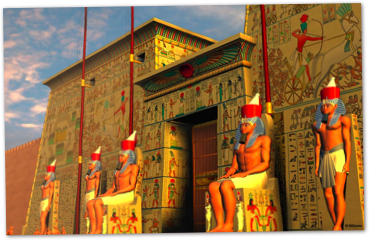




By 1425 B.C., Egyptian warrior-Pharaohs had expanded into Syria- Palestine and the Near East, south into Nubia, and West into Libya. Wealth flowed into Egypt from their new tribute states and sparked the most ambitious building program since the pyramids. Pharaohs spent lavishly on palaces and temple complexes and on the source of their new power, the army and its commanders.





One result of the pharaoh’s attention to temple complexes was the growth of power of the Egyptian priesthood. Increasingly the temple priests of Egypt became wealthier and more powerful, especially in local affairs. By 1350, the priests of Amun-Ra owned nearly a quarter of the land in Egypt. Their power began to threaten the power of the pharaoh, himself. They also threatened the prestige and power of the relatively new military aristocracy that clung to the pharaoh for their influence. Perhaps as a result of this new danger, Amenhotep IV (r. 1352-1338) announced that henceforth Egypt would worship only one god, a new deity names Aten (the disk of the sun). In 1348, the young pharaoh changed his name to Akhenaten (beloved of the sun), and moved the capital from Thebes to a new capital he constructed called Akhetaten (horizon of the sun – Arabic name Tell el Amarna). The new religion was a royal religion, its rites conducted by the Pharaoh and his family. It was supported by the military aristocracy and the Pharaoh’s court, but was not very well received by other Egyptians. The very conservative Egyptians had no desire to change their religion. In around 1336, Akhenaton died and his son Tutankhaten came to the throne. Shortly thereafter, the young pharaoh’s name was changed to Tutankhamen, and the court returned to Thebes. Amarna was abandoned to the desert, as was Egypt’s brief experimentation with monotheism.


Tutankhamen’s successors were all military men who expanded Egypt’s power in the ancient world, and the prestige of the pharaoh after Akhenaten’s dangerous experiment. The most important of these was the great warrior-builder pharaoh, Ramses II. Ramses was an amazing builder, constructing about one half of all of the extant monuments in Egypt. He fought a number of campaigns, and was largely successful in maintaining the greatness of the Egyptian Empire in the face of new and dangerous Eastern and Western kingdoms. He also tried his best to insure the dynastic future of his family by siring some 160 children (with the aid of a pretty impressive harem). His 60-year reign was about the longest of any pharaoh. In many ways, Ramses’ reign marks the high point of Egyptian history, and as we will see, the end of the Age of Bronze and beginning of a new threat, not only to Egypt, but to all of the ancient world.

Above: The Egyptian Empire created by Egypt’s New Kingdom Pharaohs.
Below: Akhenaten and family worshipping Aten, the disk of the sun.
